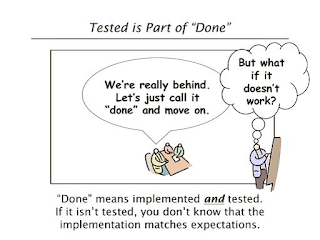Principle 1
On Agile teams, we build the product well from the beginning, using testing to provide feedback on an ongoing basis about how well the emerging product is meeting the business needs.This sounds like a small shift, but it has profound implications. The adversarial relationship that some organizations foster between testers and developers must be replaced with a spirit of collaboration. It’s a completely different mindset.
Principle 2
{Continuous testing is the only way to ensure continuous progress.}
Principle 3
The need to get all testing done in an iteration may mean that the team simply cannot do as much in each sprint as they originally thought. If this is the case, then Agile has made visible the impedance mismatch between test and dev that already existed. And that means that the team was not going as fast as they thought. They appeared to be going quickly because the developers were going fast. But if the testing isn't done, then the features aren't done, and the team just does not have the velocity they think.
Principle 4
Measure the time between when a programmer writes a line of code and when someone or something executes that code and provides information about how it behaves. That’s a feedback loop. If the software isn’t tested until the very end of a long release, the feedback loops will be extended and can be measured in months. That’s too long. Shorter feedback loops increase Agility. Fortunately, on Agile projects the software is ready to test almost from the beginning. And Agile teams typically employ several levels of testing to uncover different types of information.
Principle 5
Principle 6
This principle is an example of the discipline that Agile teams have. It takes tremendous internal discipline to fix bugs as they are found. If it’s a genuine bug, as opposed to a new story, it is fixed within the iteration. To do otherwise is like cooking in a filthy kitchen: it takes longer to wade through the mess to do the cooking, and the resulting food may or may not be edible.
Principle 7
Instead of writing verbose, comprehensive test documentation, Agile testers:
• Use reusable checklists to suggest tests
• Focus on the essence of the test rather than the incidental details
• Use lightweight documentation styles/tools
• Capturing test ideas in charters for Exploratory Testing
• Leverage documents for multiple purpose
Principle 8
Agile teams don’t count something as “done,” and ready to be accepted by the Product Owner or Customer until it has been implemented and tested.
Principle 9
Tests provide concrete examples of what it means for the emerging software to meet the requirements. Defining the tests with the requirements, rather than after, and using those tests to drive the development effort, gives us much more clear done criteria and shared focus on the goal.









No comments:
Post a Comment